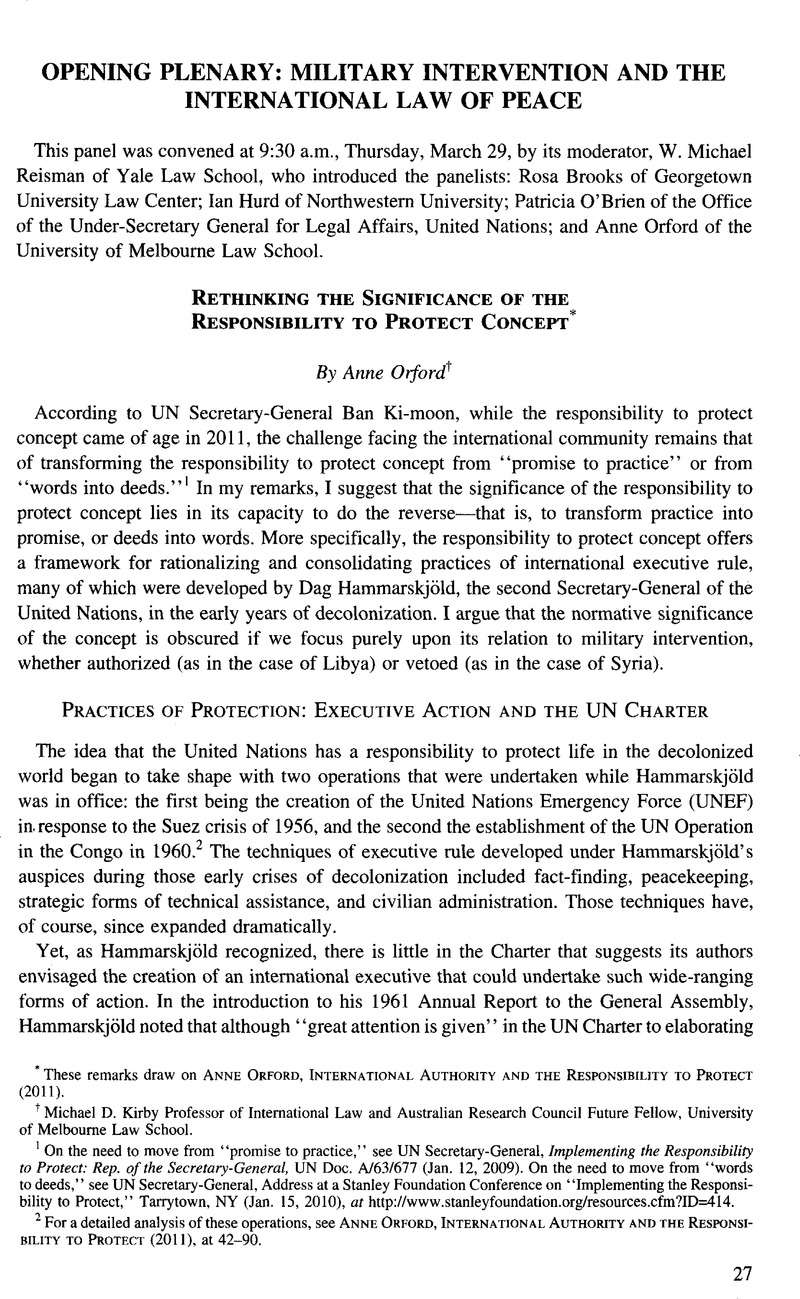No CrossRef data available.
Article contents
Rethinking the Significance of the Responsibility to Protect Concept*
Published online by Cambridge University Press: 28 February 2017
Abstract

- Type
- Opening Plenary: Military Intervention and the International Law of Peace
- Information
- Copyright
- Copyright © American Society of International Law 2012
Footnotes
These remarks draw on Anne Orford, International Authority and the Responsibility to Protect (2011).
References
1 On the need to move from “promise to practice,” see UN Secretary-General, Implementing the Responsibility to Protect: Rep. of the Secretary-General, UN Doc. A/63/677 (Jan. 12, 2009). On the need to move from “words to deeds,” see UN Secretary-General, Address at a Stanley Foundation Conference on “Implementing the Responsibility to Protect,” Tarrytown, NY (Jan. 15, 2010), at http://www.stanleyfoundation.org/resources.cfm?ID=414.
2 For a detailed analysis of these operations, see Anne Orford, International Authority and the Responsibility to Protect (2011), at 42-90.
3 UN Secretary-General, Introduction to the Annual Report of the Secretary-General on the Work of the Organization, at 5, UN Doc. A/4800/Add.l (1961).
4 Hammarskjold, Dag, The International Civil Servant in Law and in Fact, in the Servant of Peace: A Selection of the Speeches and Statements of Dag Hammarskjold 329, 334 (Foote, Wilder ed., 1962)Google Scholar. See also Orford, supra note 2, at 10-11.
5 UN Secretary-General, supra note 3, at 1.
6 Id.
7 UN Secretary-General, Second and Final Report of the Secretary-General on the Plan for an Emergency International United Nations Force Requested in the Resolution Adopted by the General Assembly on 4 November 1956 (A/3276), para. 19, UN Doc. A/3302 (Nov. 6, 1956).
8 Schwebel, Stephen M., The Origins and Development of Article 99 of the Charter, 28 Brit. Y.B. Int’l L. 371, 382 (1951)Google Scholar.
9 Schachter, Oscar, Dag Hammarskjold and the Relation of Law to Politics, 56 AJIL 1, 8 (1962)CrossRefGoogle Scholar.
10 Id.
11 Sir Pierson Dixon, “The Secretary General of the United Nations: Mr Dag Hammarskjold,” confidential memorandum to Mr. Selwyn Lloyd (Jan. 16, 1958), FO371/137002/UN2303/1 (National Archives, Kew).
12 Press Release, United Nations, Secretary-General Defends, Clarifies “Responsibility to Protect” at Berlin Event on “Responsibility to Protect: International Cooperation for a Changed World,” UN Press Release SG/SM/11701 (July 15, 2008).
13 UN Secretary-General, supra note 1, at 7.
14 UN Secretary-General, Early Warning, Assessment and the Responsibility to Protect: Report of the Secretary-General, at 4, 8, UN Doc. A/64/864 (July 14, 2010).
15 H.L.A. Hart, The Concept of Law 32 (1961).
16 See also Orford, Anne, What Kind of Law it This? London Rev. Books Blog (Mar. 29, 2011)Google Scholar, http://www.lrb.co.uk/blog/?s=%22Anne+Orford%22.
17 Letter Dated 9 November 2011 from the Permanent Representative of Brazil to the United Nations Addressed to the Secretary-General, Annex, UN Doc. A/66/551-S/2011/701 (Nov. 11, 2011).




